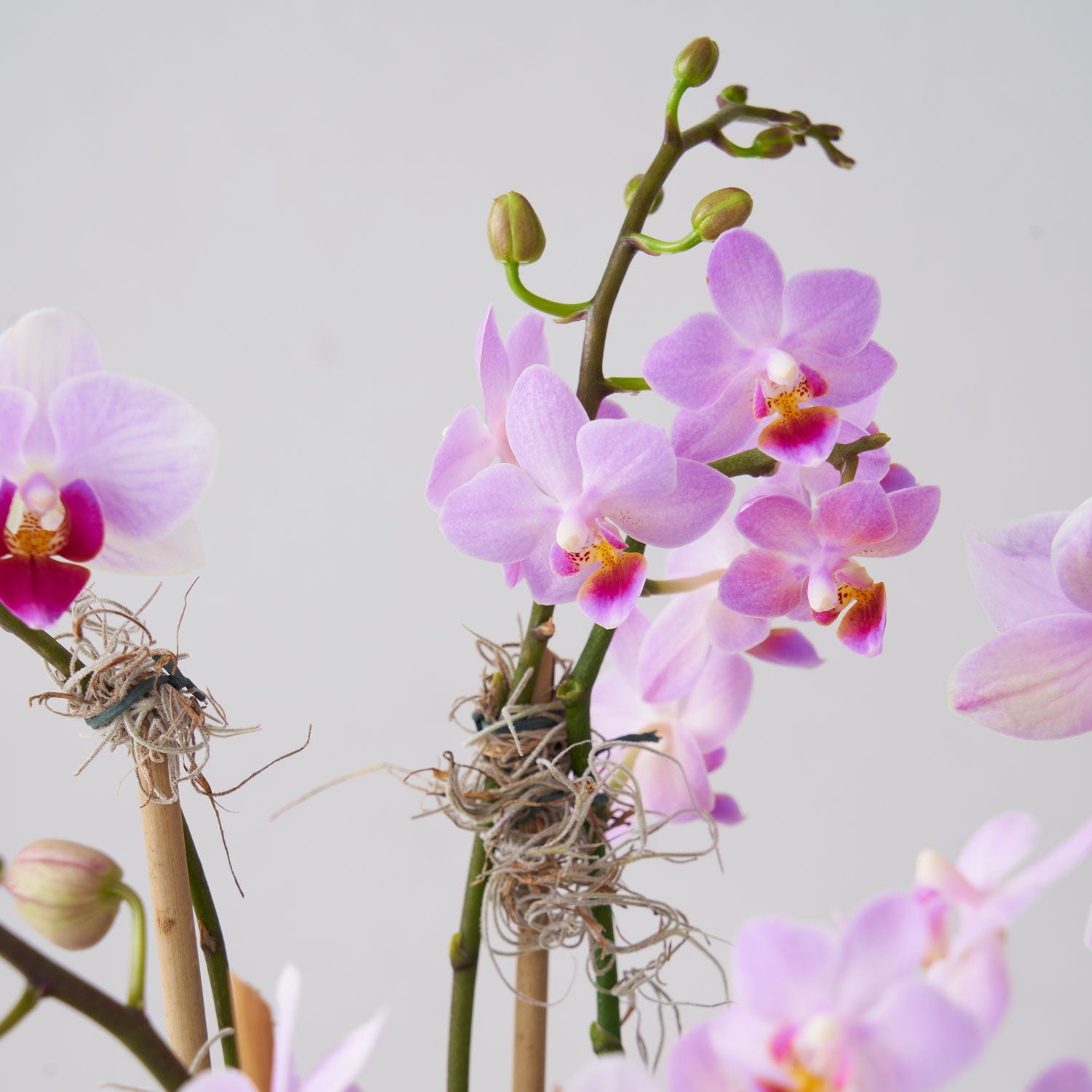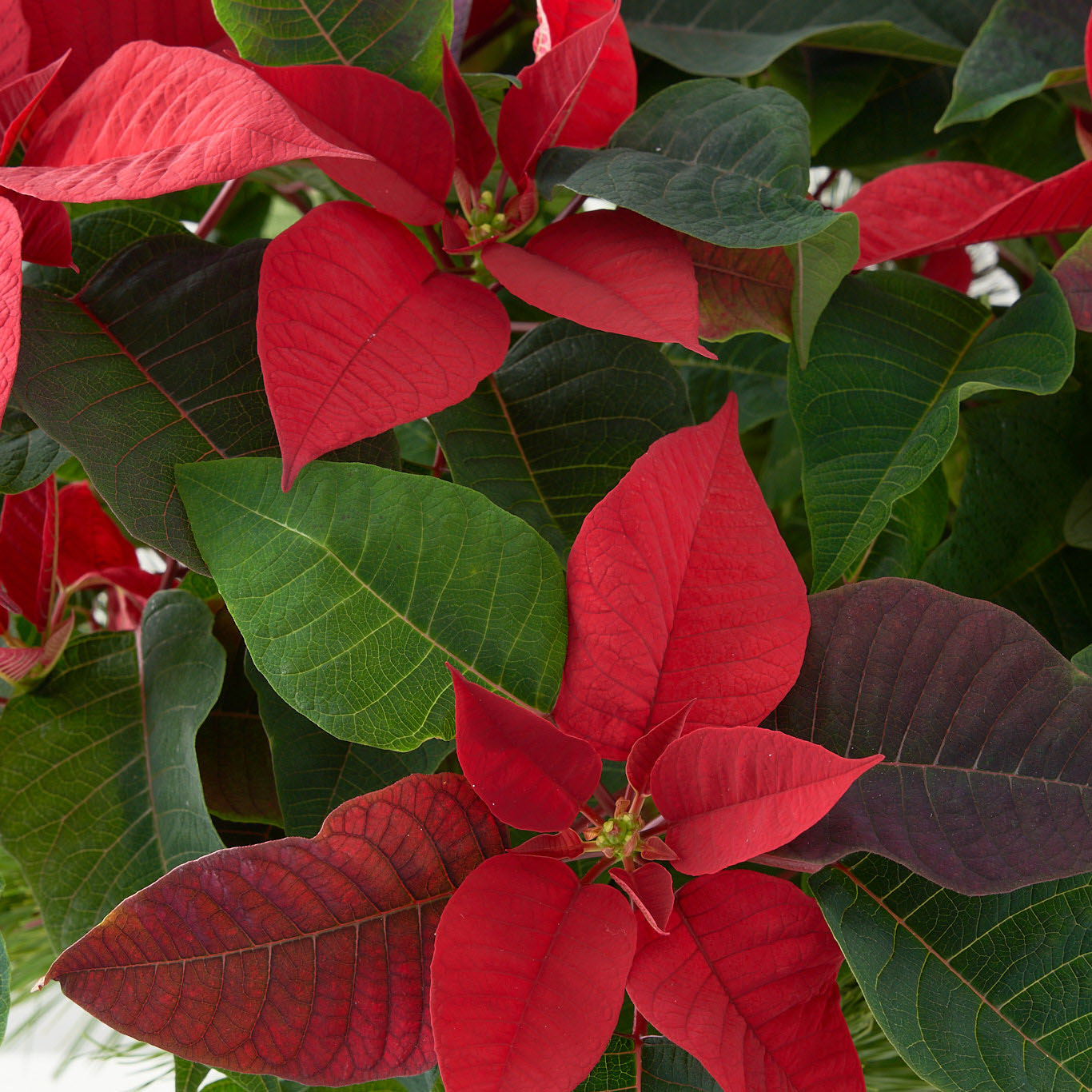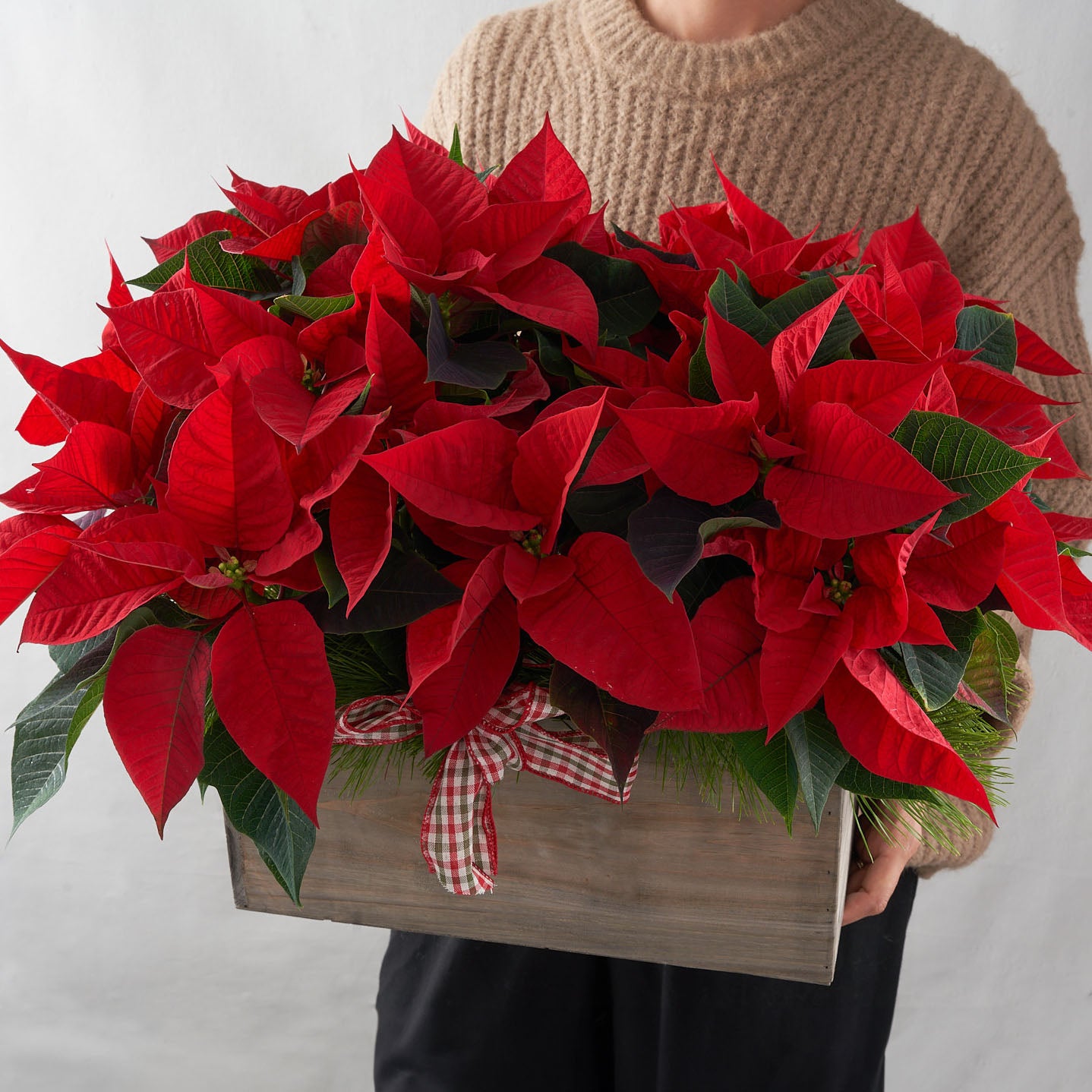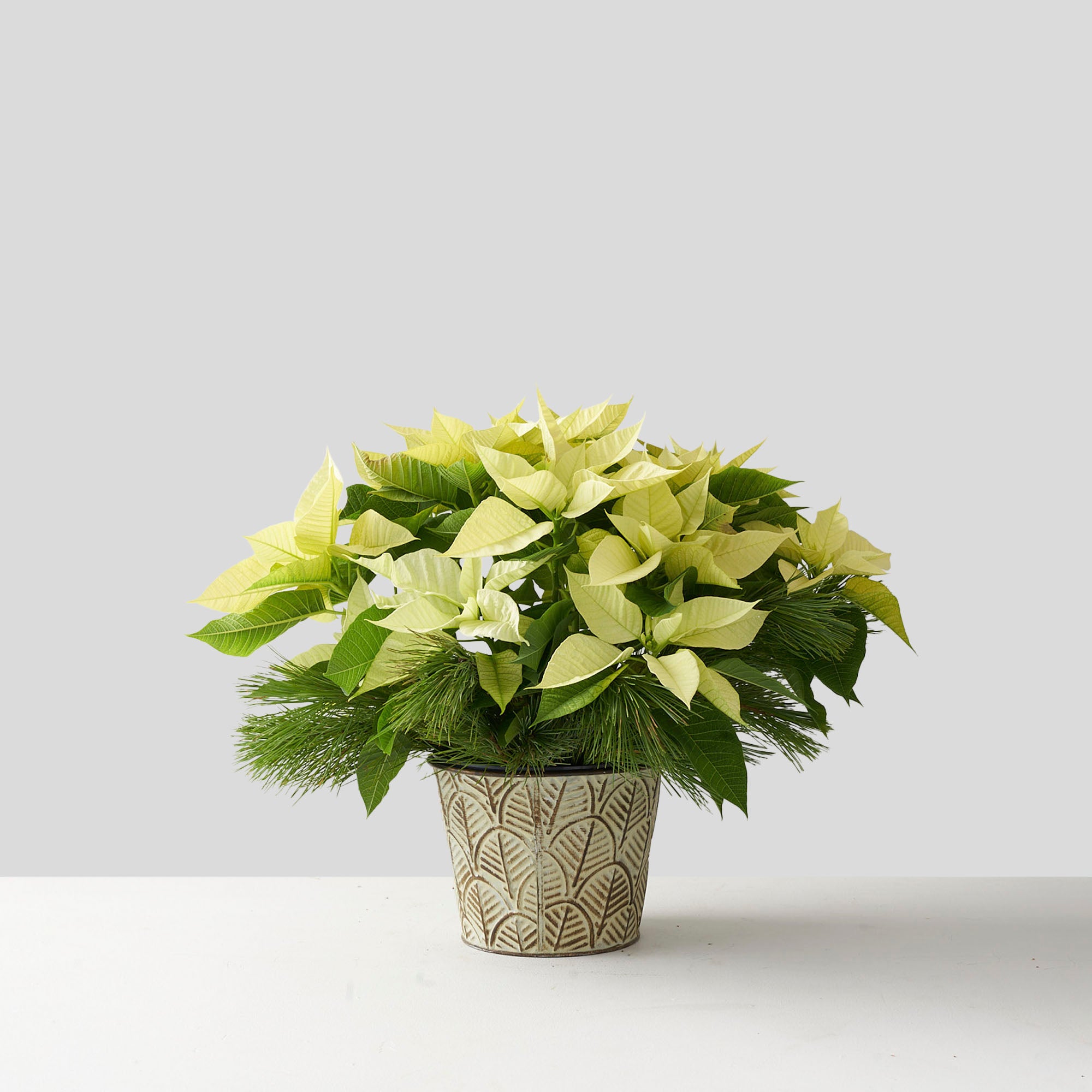Discover tips from flower experts on how to keep poinsettias vibrant, healthy, and full of colour all season long.
With their bright red leaves and festive charm, poinsettias are a holiday favourite. This guide tells you everything you need to know about how to care for poinsettias – from the right watering techniques to the ideal lighting and temperature – to keep them healthy and vibrant all season long.
Poinsettias: the Iconic Holiday Plant
Poinsettias are the quintessential holiday plant, thanks to their vibrant red and green foliage. They are widely used to adorn homes, offices, and public spaces with a festive spirit throughout the holiday season. They can make a striking centrepiece on a table or a warm welcome by the front door.
Meaning of Poinsettias
Poinsettias ( Euphorbia pulcherrima) are native to Mexico. They are often mistaken for flowers, but in fact are plants with vibrant red, pink, white, or variegated leaves called bracts. Due to their striking, festive colours, poinsettias have become symbolic of the holiday season, particularly Christmas.
Did you know?
Poinsettias are named after botanist, physician and first U.S. ambassador to Mexico, Joel Roberts Poinsett, who introduced these vibrant plants to the United States in the 1820s. In Mexican culture, poinsettias are called La Flor de Nochebuena (The Christmas Eve Flower) and symbolize purity, joy, and good cheer.
How to Care for a Poinsettia Plant
Follow these expert poinsettia care tips for keeping poinsettia plants lush throughout the season.
Optimal Light Conditions for Poinsettias
Poinsettias thrive in bright, indirect sunlight. Avoid exposing them to direct sunlight, which can cause the leaves to burn, or to too little light, which may lead to leaf drop.
- The best light for poinsettias is near a well-lit window, ideally one facing east or west.
- If your space has limited exposure to natural light, use a grow light to help keep your poinsettia looking its best.
- Rotate your poinsettia plant every few days for even light exposure, balanced growth, and to retain its vibrant colour.
Ideal Temperature and Humidity for Poinsettias
Poinsettia temperature needs are pretty easy: stable, moderate temperatures and humidity levels are all you need to keep them happy. Avoid placing your poinsettia plants near drafts, heating vents, or cold windows, as sudden changes can cause the leaves to wilt or drop.
- Keep your poinsettia in temperatures between 18-21°C during the day and around 15°C at night.
- If your poinsettia is exposed to a more dry environment, use a humidity tray or lightly mist the plant to prevent the leaves from drying out.
Watering Poinsettias: Essential Tips
Poinsettias need proper watering to remain healthy. Never let the soil dry out completely, as this can stress the plant and cause leaves to wilt or fall. On the other hand, poinsettias do not tolerate soggy soil either.
-
Water the plant thoroughly when the top inch of soil feels dry to the touch.
-
Remove any water left in the saucer after watering, as it can lead to root rot.
-
Poinsettias generally need less water during the winter. Check the soil frequently and adjust your watering schedule as needed.
These poinsettia watering tips will help prevent issues and keep your plant thriving throughout the holiday season.
Feeding and Fertilizing Poinsettias
Poinsettias don’t need fertilizing while they’re in bloom during the holiday season. Following the above These poinsettia health tips will be enough.
On the other hand, if you want to keep your poinsettia long-term, adding fertilizer regularly during the plant’s growing season will help keep it healthy and vibrant.
- After the holidays, start fertilizing your plant once a month with a balanced, water-soluble fertilizer at half strength. This will encourage new leaves and help the plant maintain its colour.
- Avoid over-fertilizing, which can burn the leaves and weaken the plant.
These poinsettia health tips for feeding and fertilizing can help keep poinsettias vibrant even after the holiday season.
Extending Poinsettia Lifespan After the Holidays
With a bit of holiday plant care, your poinsettias can continue to thrive long after the holiday season.
- Once the coloured bracts fade, prune the plant back to about 6-8 inches tall.
- Continue to expose the plant to bright, indirect light, moderate temperatures, and regular watering.
- In early spring, repot the poinsettia into fresh soil if needed.
- In summer, place it outdoors in a partially shaded area and bring it back inside before temperatures start to drop.
- In fall, to encourage new bract colour, give your poinsettia 14-16 hours of darkness each night starting in early October to mimic shorter daylight hours.
These steps on how to keep poinsettias alive and encourage rebloom can help make your poinsettia a long-lasting part of your decor.
Did you know?
Poinsettias are toxic to pets. Learn more from the Pet Poison Helpline.
Common Poinsettia Problems and Solutions
Poinsettia plants are relatively easy to care for, but they can encounter a few issues:
- Leaf drop – Often occurs when the plant is exposed to drafts, inadequate light, or underwatering.
Solution: Give the plant steady light exposure and consistent watering. Keep it away from drafts and heat sources.
- Yellowing leaves - Often a sign of overwatering.
Solution: Make sure the pot drains well and reduce watering.
- Pests – Whiteflies, spider mites or other pests may occasionally appear.
Solution: Treat your plant with a gentle insecticidal soap or a rinse with water.
Enjoy Vibrant Poinsettias All Season Long – and Beyond
With the right poinsettia care, your plant can last several months beyond the holiday season. And if you encourage regrowth, such as pruning, repotting, and adjusting light exposure for seasonal changes, it can last and rebloom for several years.
In fact, many dedicated poinsettia enthusiasts manage to keep their plants thriving and colourful year after year.
We hope these poinsettia holiday plant care tips have come in handy. Here’s to making this year’s new poinsettia a long-lasting part of your holiday traditions!



















